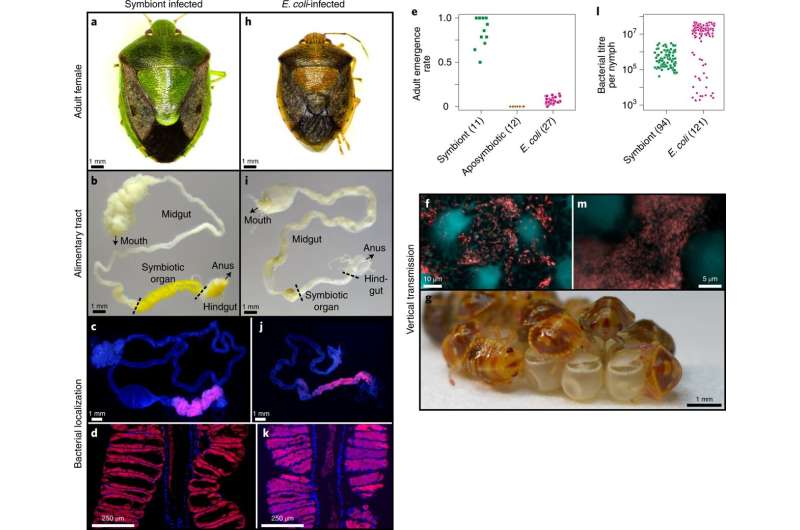August 17, 2022 report
Engineering a symbiotic relationship between E. coli and stinkbugs reveals clues about how symbiosis develops

A team of researchers with members affiliated with several institutions in Japan has learned more about the process involved in the development of natural symbiotic relationships by engineering an artificial one between E. coli and stinkbugs.
In their paper published in the journal Nature Microbiology, the group describes how they forced a symbiotic relationship between the bacteria and the insect and what doing so showed them about the evolution of such relationships. Martin Kaltenpoth, with the Max Planck Institute for Chemical Ecology, has published a News & Views piece in the same journal issue outlining the work done by the team in Japan.
Prior research has shown that there are very large numbers of examples of symbiotic relationships in the natural world—the bacteria in the human gut that help process food, for example. But little is known about how such relationships come to exist. In this new effort, the researchers sought to learn more about the process that can lead to very different creatures benefiting mutually from each other's abilities.
The work by the team involved removing Pantoea sp. bacteria from crypts in the gut of several stinkbugs—prior research has shown that the bacteria is necessary for its survival—and replacing it with E. coli. Predictably, just five to ten percent of the stinkbugs survived. Also, those that survived were not very healthy—they turned from green to brown and shrank in size.
The researchers collected E. coli from the healthiest bugs and placed them in the next generation. They did this over and over for successive generations until the stinkbugs began to look healthy again. Once they became as healthy as those in a control group, the researchers collected samples of E. coli from them and undertook a genetic analysis of them to find out what sorts of changes they had undergone to make them useful to the stinkbug.
They found that just one mutated gene made the difference—one that was involved in disrupting the carbon catabolite repression pathway. The researchers were not able to pinpoint why exactly such a mutation made a difference but suspect it had to do with helping the stinkbug get rid of unhealthy carbon sources. They also note that their work has opened the door a little bit to understanding how symbiotic relationships evolve.
More information: Ryuichi Koga et al, Single mutation makes Escherichia coli an insect mutualist, Nature Microbiology (2022). DOI: 10.1038/s41564-022-01179-9
Martin Kaltenpoth, Fast track to mutualism, Nature Microbiology (2022). DOI: 10.1038/s41564-022-01188-8
Journal information: Nature Microbiology
© 2022 Science X Network





















